Reliable safety EN 131 – the most important improvements.
EN 131-1+2*, the standard that applies to ladders, was comprehensively revised. The newly revised standard will come into effect throughout Europe at the latest by the end of 2017. Here we provide you with an overview of the individual tests required by the new standard as well as the most important improvements aimed at further enhancing safety when working with ladders. Please take note that a few features may no longer be available or only be partially available as a result of the new European standard for ladders.
Your benefits – always standard-compliant with ZARGES
- Stay on the safe side legally
ZARGES ladders meet the requirements of all relevant product standard and offer market leading performance. They meet the standard for “Professional” class. In this way you can be sure that ZARGES ladders are as professional as you are, regardless of whether in skilled trades, the industry or a household setting. - Work safely
The new, more stringent tests have shown: that the standard-compliant ZARGES ladders are highly stable and slip-resistant. This helps you avoid risks, reduce accidents as much as possible, and minimise loss of working hours. - Fulfilling requirements throughout Europe
The new version of EN 131-1+2 is applicable throughout Europe. Regardless of where you are active in Europe: ZARGES ladders fulfil with the requirements of the standards in the whole of Europe. - One-off investment, long-term benefits
ZARGES ladders are even more robust and durable thanks to the new, more stringent tests set out in the revised standard. That is why when you buy a ZARGES ladder, you are investing in not only safety, but also a piece of access equipment that will accompany you for a very long time.
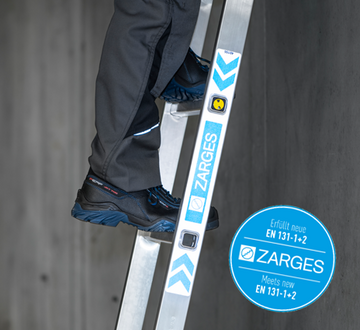
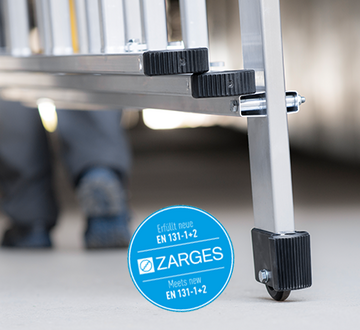
EN 131-1+2 – what has changed?
- Classification “Professional” & “Non-professional”: In future, ladders will be classified into two categories. The “Professional” category is for ladders that are intended for use in a professional setting. Ladders that are meant for household use are categorised as “Non-professional”. All ZARGES ladders are classified as “Professional” without exception.
- More stringent tests – more robust ladders: Additional tests as well as stricter tests bring ladders to their limits. But not ZARGES ladders. Ladders by ZARGES pass all these tests with flying colours.
- Wider base: All ladders 3,000 mm or longer that can be used as a leaning ladder are required to have a base stabiliser. Safer and more stable standing for a wide range of tasks.
IMPORTANT: For push-up ladders that are longer than 3,000 mm when retracted, the individual ladder parts are no longer allowed to be used separately because of this new requirement. For multipurpose ladders that are longer than 3,000 mm when retracted, the upper ladder can no longer be used separately; such ladders are also no longer allowed to be used on stairs.
FAQs on EN 131-1+2
What is EN 131?
- EN 131 is the European standard for portable ladders.
- In the six-part standard, rules are laid down for the construction, inspection, labelling and instruction manual of ladders in order to ensure uniform quality and safety standards throughout Europe.
- The new version of EN 131-1 was already published in late 2015, with the new version of EN 131-2 following in January 2017. Both have a transition period that will last until the end of 2017.
- In the new version of EN 131-2, all ladders are categorised into two classes:
The “Professional” category is for ladders that are intended for use in a professional setting.
Ladders that are meant for household use are categorised as “Non-professional”. - The testing requirements for the "professional" class have become stricter and harder.
How will ladders change according to the standard?
All ladders 3,000 mm or longer that can be used as a leaning ladder are required by the new standard to have a base stabiliser.
Because of this new requirement, a few features are no longer available for multi-part ladders:
- For push-up ladders that are longer than 3,000 mm when retracted, the ladder parts are no longer allowed to be used separately.
- For multipurpose ladders that are longer than 3,000 mm when retracted, the upper ladder can no longer be used separately; such ladders are also no longer allowed to be used on stairs.
Why was the previously existing standard revised? And who was responsible for the revision?
The change was initiated by consumer protection organisations and the standard was revised by the European Committee for Standardization (CEN).
Other organisations involved include
- Testing institutes
- Occupational insurance associations
- Manufacturers
When does the revised EN 131-1+2 standard take effect?
- EN 131-1: May 2016
- EN 131-2: July 2017; however, manufacturers are given a transition period that will last until the end of 2017 to implement the new requirements.
Who do the standards apply to?
The standards apply to all manufacturer and resellers that place access systems on the market in Europe.
What kind of access systems are affected by the new standards?
This European standard is applicable to portable ladders. However, it does not apply to ladders used in specialist applications, such as fire ladders, roof ladders and mobile ladders. EN 131-4 is applicable to single- or multiple-joint ladders, EN 131-6 to telescopic ladders, and EN 131-7 to mobile ladders with platform. EN 131-1+2 is also not applicable to step stools; the relevant standard is EN 14183 in this case.
How about my existing ladders? Am I allowed to continue using them?
Are ladders that fulfil the old EN 131-1 standard still allowed to be use for commercial purposes?
Old ladders are generally not exempted from new standards, in both production and sales.
Employers are on the safe side legally only when
they upgrade their ladders to keep pace with the state of the
art following a risk assessment.
It is safe to assume that very similar statutory provisions apply in EU countries. We can therefore say that this statement is applicable throughout Europe.
How do I tell whether a product has been manufactured in compliance with the new standard?
Since April 2017, all ladders supplied by ZARGES fulfil the new standard applicable to the “Professional” class. You can recognise ZARGES ladders that comply with EN 131-1+2 by looking for this blue sticker affixed to the products themselves.
If you see this sticker on a ladder, you can be sure that the ladder fulfils the requirements according to EN 131-1:2015 and EN 131-2:2010+A2:2017. Our ladders have already been inspected and certified by TÜV according to the new standards.
What is going to happen to ladders that still only comply with the old standard?
The new standard does not expressly prohibit the continued use of existing ladders. However, commercial users (companies, public authorities, etc.) in Europe have to comply with the respective occupational regulations. These regulations set out “the minimum safety and health requirements for the use of work equipment by workers at work”. In Germany, these regulations are implemented in the German Industrial Safety Regulations [BetrSichV].
An important element is the obligation to ensure work equipment keeps pace with the state of the art. In addition, it is necessary to carry out a risk assessment (for ladders, e.g. according to TRBS 2121 Part 2) as well as regular inspections on work equipment.
Does ZARGES have any advice concerning what to do with existing ladders?
We advise companies to assess their access system with regard to safety – apart from the yearly ladder inspections. In order to react in a timely manner, you should also start as early as possible: conduct a risk assessment now and implement the necessary measures before the end of the transition period (end of 2017).
What is the process of a risk assessment? And what is the process of evaluating whether a ladder can continue to be used?
A good guide for such a risk assessment can be found in TRBS 2121 Part 2. Alternatively you can obtain such information from specialist companies or manufacturers. But take note: Only the user can evaluate and decide whether the ladder can continue to be used. Do not forget to document this assessment.
Will the guidelines for ladder inspections change too?
No, they are not going to change. Companies still need to perform ladder inspection once a year in order to ensure that the access systems in use correspond to the state of the art and therefore comply with statutory provisions, and that these systems do not show signs of damage.
Can I upgrade existing ladders too?
Yes! Access systems can be upgraded to conform to regulations. For example, a horizontal stabiliser bar can be mounted on leaning ladders to make them compliant with EN 131-1.
How can I be sure that an upgraded ladder complies with all standards?
It is not always the case that an upgrade will fulfil both parts of the standard (131-1 and 131-2). Therefore, this should be additionally assessed.
I am a distributor. Am I allowed to sell only ladders that comply with the new standard from 01 January 2018 onwards?
Yes. According to Section 6 (5) of the German Product Safety Act [ProdSG], “the distributor shall contribute to making only safe consumer products available on the market”. This can only be ensured when the products correspond to the state of the art.
What advantages does the new standard offer?
- Stay on the safe side legally: ZARGES ladders fulfil the requirements of the German occupational safety and health law and are on the cutting edge of technology. They meet the standard for “Professional” class.
- Improved work safety: The new, more stringent tests have shown that the standard-compliant ZARGES ladders are highly stable and slip-resistant. This helps to better prevent accidents and reduce loss of working hours.
- Europe-wide work safety: The newly revised EN 131-1+2 is applicable throughout Europe. Regardless of where you are active in Europe, ZARGES ladders fulfil the requirements of this standard.
- Benefit for a long time from a one-time investment: ZARGES ladders are even more robust and durable thanks to the new standard.
What’s new in EN 131-2? How is it tested?
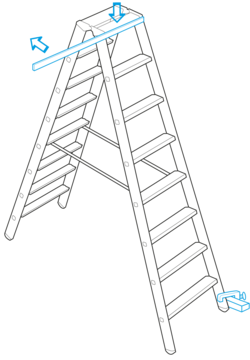
Requirement “Torsion Stepladder”
What is tested:
- Torsional stiffness
How is it tested:
- One of the ladder feet is secured using a clamp.
- A load of 736 N is applied to the ladder platform.
- Subsequently, a lateral pulling force of 137 N is applied to the ladder.
The requirement:
- When the test load is being applied, the other ladder foot should not move more than 25 mm from its original position.

Requirement “Continuous Stress”
What is tested:
- Durability of the ladder
How is it tested:
- A load of 1,500 N is applied alternately between the topmost step/rung and the middle step/rung of the ladder
- Repetitions for “non-professional”: 10,000 cycles
- Repetitions for “professional”: 50,000 cycles
The requirement:
- There should be no damage to the ladder.
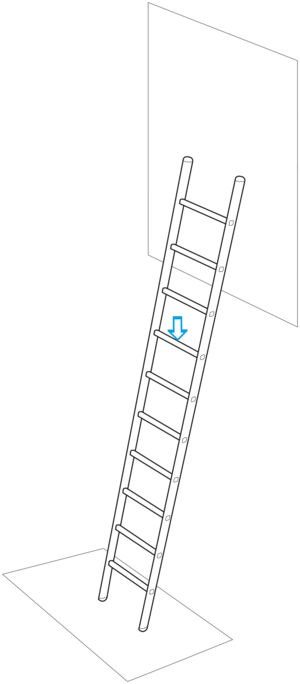
Requirement “Base Slip”
What is tested:
- Slip-resistance of the ladder end caps.
How is it tested:
- The ladder is placed standing on a glass panel.
- The ladder is subject to a concentric load of 1,471 N.
- The load is applied 4 times to the ladder.
The requirement:
- The feet of the ladder should not slide more than 40 mm within 1 minute.
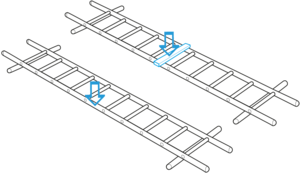
Requirement “Torsion Leaning Ladders”
What is tested:
- Torsional stiffness
How is it tested:
- The first step involves applying a concentric load of 491 N to the ladder for 30 seconds. This is done to determine the initial value.
- In the next step, a concentric load of 638 N is applied to one of the stiles and the deformation of both stiles are measured relative to the initial value.
The requirement:
- The difference between the deformation of the two stiles should not exceed 0.07 times of the ladder width.
An overview of the new requirements and tests according to DIN EN 131-1+2
Safety first: According to the latest version of the EN 131-1+2 standard, ladders are required to fulfil additional as well as stricter requirements. You can read about the new or stricter tests in the overview.
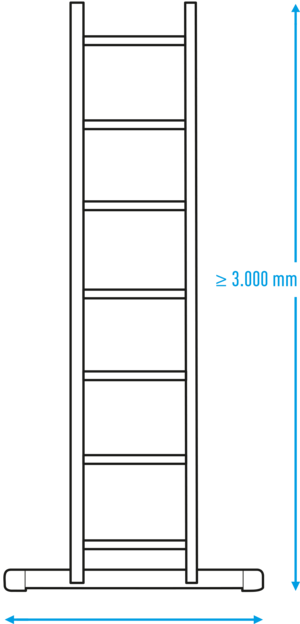
Requirement “Base Stabiliser”
The new requirement:
- All ladders 3,000 mm or longer that can be used as a leaning ladder are required by the new standard to have a base stabiliser.
- The required width of the base stabiliser may be up to 1,200 mm, depending on the length of the ladder.
Note!
Because of this new requirement, a few features are no longer available for multi-part ladders:
- For push-up ladders that are longer than 3,000 mm when retracted, the ladder parts are no longer allowed to be used separately.
- For multipurpose ladders that are longer than 3,000 mm when retracted, the upper ladder can no longer be used separately; such ladders are also no longer allowed to be used on stairs.
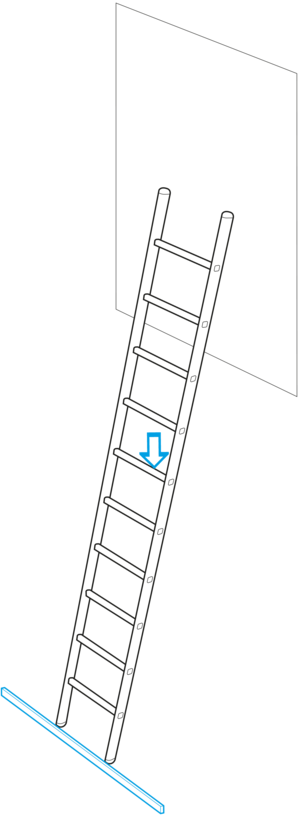
Requirement “Stile Strength”
What is tested:
- The strength of the stiles
How is it tested:
- The step/rung is subject to an eccentric test load of 2,700 N (for the “Professional” category)
or 2,250 N (for the “Non-professional” category) in its usual use position.
The requirement:
- The ladder must not be damaged and must retain its functionality.
ZARGES – safety is our standard
The philosophy of ZARGES: Safety first. This is why ladders made by ZARGES today comply with current national and international standards. And our certified development and manufacturing processes are guaranteed to give you safety and the highest reliability.
You can find more information on our quality standards and other important topics relating to the safety of our ladders by clicking on the following links:
Download information brochure
Do you have any questions concerning our products or the changes to the standards?
You can get in touch with our service team by
Phone: +49 881 687-100
E-mail: vertrieb@zarges.de
or simply use our contact form
